Virtualization Software Market Size and Share
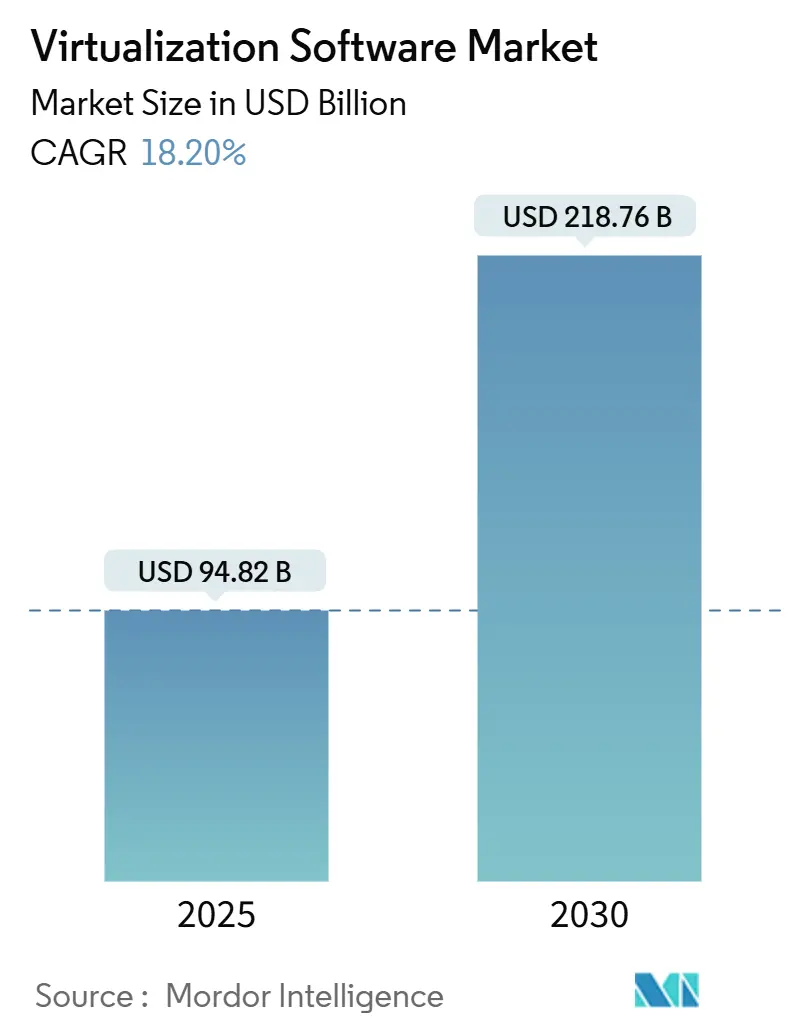
Virtualization Software Market Analysis by Mordor Intelligence
The Virtualization Software Market size is estimated at USD 94.82 billion in 2025, and is expected to reach USD 218.76 billion by 2030, at a CAGR of 18.20% during the forecast period (2025-2030). A decisive shift toward hybrid infrastructure, higher cloud spending, and the spread of AI-optimized workloads all contribute to the robust outlook. Broadcom’s integration of VMware has altered vendor economics by widening license fees, prompting enterprises to diversify suppliers and accelerate trials of open-source or cloud-native hypervisors. Edge computing roll-outs, tighter industry compliance mandates, and a permanent hybrid-work culture are broadening virtualization use cases across datacenters, branch sites, and mobile endpoints. North American buyers are driving optimization initiatives, while Asia-Pacific organizations are scaling first-time deployments on multi-cloud foundations. Heightened price sensitivity and evolving security requirements are encouraging automated orchestration tools, AI-driven resource allocation, and subscription-based delivery models, elements that collectively underpin long-term growth in the virtualization software market.
Key Report Takeaways
- By platform, PC and server virtualization captured 67.4% of the virtualization software market share in 2024, while mobile and endpoint virtualization are forecast to expand at a 22.1% CAGR through 2030.
- By virtualization category, server and compute technology held 46.6% revenue share in 2024; network and software-defined networking virtualization is growing the fastest at 21.2% CAGR to 2030.
- By deployment model, on-premise solutions retained 44.7% of the virtualization software market size in 2024; cloud and SaaS-hosted deployments are projected to grow at 22.8% CAGR.
- By organization size, large enterprises controlled 61.3% share of the virtualization software market size in 2024, whereas small and medium enterprises are advancing at a 23.1% CAGR.
- By end-user industry, IT and telecommunications led with 28.4% revenue share in 2024, while healthcare and life sciences are set to grow at 20.1% CAGR to 2030.
- By geography, North America held 34.6% of the virtualization software market share in 2024; Asia-Pacific is the fastest-growing region with a 21.4% CAGR forecast.
Global Virtualization Software Market Trends and Insights
Drivers Impact Analysis
| Driver | (~) % Impact on CAGR Forecast | Geographic Relevance | Impact Timeline |
|---|---|---|---|
| Cost-reduction from server consolidation | +3.2% | North America and Europe, global spill-over | Medium term (2-4 years) |
| Cloud-first enterprise IT strategies | +4.1% | North America and Asia-Pacific | Long term (≥ 4 years) |
| Remote-work and edge-compute proliferation | +2.8% | Developed markets across all regions | Short term (≤ 2 years) |
| Vendor diversification away from vSphere | +3.5% | North America and Europe | Short term (≤ 2 years) |
| AI-optimised workload placement | +2.9% | North America, Europe, China | Medium term (2-4 years) |
| Source: Mordor Intelligence | |||
Cost-reduction from Server Consolidation
Server consolidation remains an enduring financial catalyst because virtual machines let enterprises replace racks of single-purpose hardware with fewer highly utilized nodes. Government programmes that closed older data centers report consolidation ratios above 10:1, lowering energy bills and refresh budgets. [1]Ben Miller, “CTO Strategies for Virtualization in Government IT,” GovTech, govtech.com Heightened hardware costs and supply-chain lead-time concerns further elevate the importance of sweating existing assets before procuring new servers. Financial institutions cite smaller physical footprints and faster recovery objectives as added advantages. Collectively, these factors keep cost-saving imperatives central to the virtualization software market trajectory.
Cloud-first Enterprise IT Strategies
Cloud transformation now centers on sophisticated hybrid and multi-cloud blueprints that rest on virtualization as the abstraction layer. Microsoft’s cloud revenue grew 20–22% year over year to USD 42.4 billion in 2025, evidence that consumption-based models continue to scale. Asian enterprises are especially progressive; 92% of Chinese and 91% of Indian executives say their organizations run workloads in the cloud. [2]HCLTech Analysts, “Asia Leading the New Wave of Technological Transformation,” HCLTech, hcltech.com As AI workloads mature, demand rises for hypervisors that can flex compute pools quickly and predictively. Subscription licensing and API-driven automation are thus integral to the future virtualization software market.
Remote-work and Edge-compute Proliferation
Virtual desktop infrastructure and secure endpoint instances have become baseline requirements for hybrid workforces. Healthcare systems deploy virtual networks to support telemedicine, electronic health records, and bandwidth-aware video diagnostics. Concurrently, edge spending is forecast at USD 232 billion in 2024, enabling on-site analytic workloads and low-latency applications. Japan’s BIPROGY connected 4,000 Azure Virtual Desktops into its cybersecurity stack, illustrating the scale that distributed virtualization now reaches. These developments expand the addressable virtualization software market beyond core data centers.
Vendor Diversification Away from vSphere
Broadcom’s acquisition of VMware introduced license uplifts ranging from 150% to 500%, prompting CIOs to hedge platform risk through alternative hypervisors. Webinars across Japan advise customers on migration paths that keep operational consistency while reducing cost exposure. Red Hat’s OpenShift Virtualization, Proxmox VE, and KVM derivatives now feature prominently on short-lists because they preserve existing virtual-machine images while enabling container adoption. The resulting churn accelerates competitive intensity inside the virtualization software market.
Restraints Impact Analysis
| Restraint | (~) % Impact on CAGR Forecast | Geographic Relevance | Impact Timeline |
|---|---|---|---|
| Deployment and lifecycle-management complexity | -1.8% | SMB segment worldwide | Medium term (2-4 years) |
| Escalating hypervisor licence costs | -2.3% | North America and Europe | Short term (≤ 2 years) |
| Rising VM-specific security attack surface | -1.1% | Highly regulated industries | Long term (≥ 4 years) |
| Source: Mordor Intelligence | |||
Deployment and Lifecycle-management Complexity
Hybrid architectures multiply toolsets and policy domains, making day-two operations a challenge for teams that lack deep virtualization expertise. Government agencies cite budget limits and culture change as hurdles when modernizing entrenched legacy stacks. Smaller businesses often outsource management but encounter new dependencies and contractual overhead. Consistency across disparate clouds, hypervisors, and security baselines thus restrains a portion of the virtualization software market until automation matures further.
Escalating Hypervisor Licence Costs
Broadcom’s subscription-only bundles require larger core counts and impose renewal penalties, shifting procurement from capex to unavoidable opex. Many customers report five-fold pricing spikes and limited negotiation windows. Industries under strict audit regimes hesitate to switch platforms quickly because new environments must pass expensive compliance testing. As a result, cost pressure may slow net-new deployments even while it stimulates vendor switching.
Segment Analysis
By Platform: Mobile Endpoints Drive Virtualization Evolution
In 2024, PC and server technology accounted for 67.4% of the virtualization software market size, yet growth momentum has shifted toward mobile and endpoint use cases, advancing at 22.1% CAGR to 2030. The enduring lead of traditional server hypervisors reflects deep enterprise install bases; however, hybrid work patterns now demand secure remote desktops accessed from unmanaged devices. Healthcare systems and financial firms deploy virtual desktops to segment sensitive applications, ensuring compliance with HIPAA and PCI while enabling broad workforce reach. [3]Bill Siwicki, “5 Benefits of Moving Your Healthcare System to a Virtualized Network,” Healthcare IT News, healthcareitnews.com Japan’s Azure Virtual Desktop roll-out illustrates the scale possible when cybersecurity frameworks and endpoint virtualization converge.
Market preference is shifting toward platforms that combine zero-trust security models with AI-assisted session optimization. Vendors that integrate user-behaviour analytics and dynamic policy enforcement can differentiate in the virtualization software market. Enterprises also weigh device-agnostic clients, lower bandwidth codecs, and simplified licensing as purchase criteria. The convergence of endpoint virtualization with identity services and secure access service edge (SASE) offerings presents further growth levers over the forecast horizon.
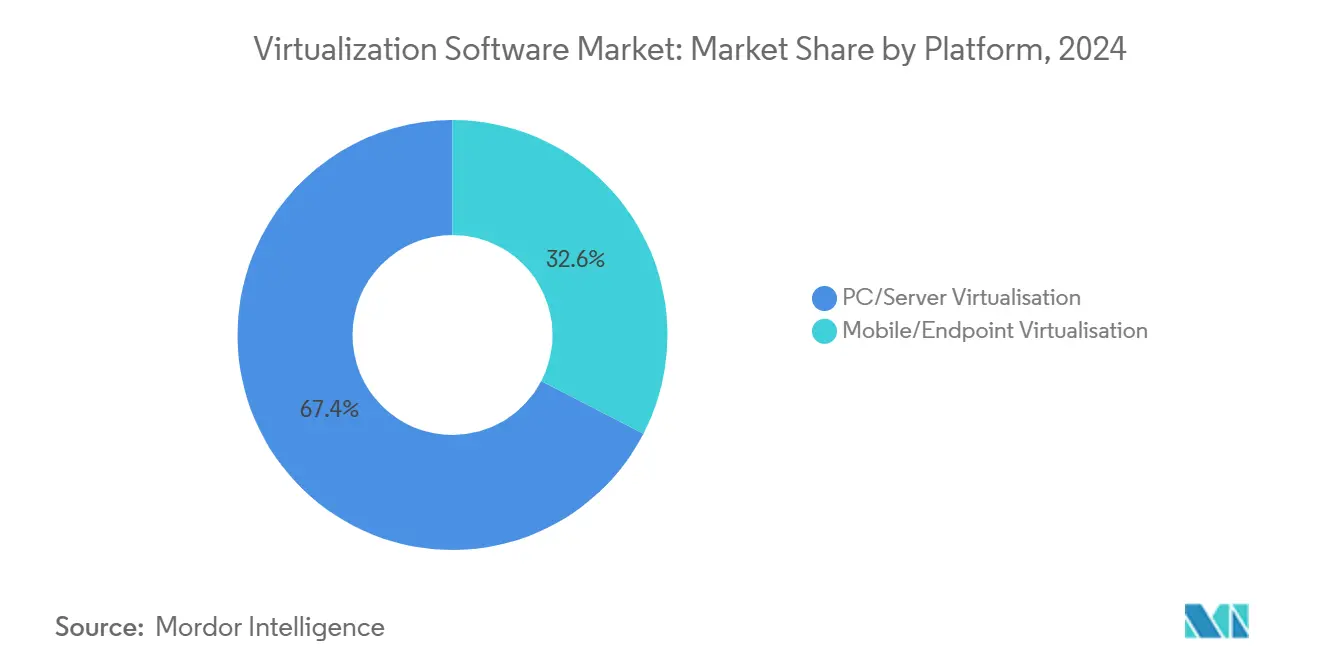
By Virtualisation Category: Network Transformation Leads Growth
Server and compute workloads represented 46.6% of the virtualization software market share in 2024, but network and software-defined networking virtualization is on track for a 21.2% CAGR to 2030. Organizations implementing 5G private networks and edge workloads require programmable network overlays that adjust to latency-sensitive applications. Broadcom’s VeloSky product bundles fiber, cellular, and satellite links via virtualized infrastructure, underscoring where innovation is heading.
Enterprises in Asia-Pacific increasingly bypass legacy routers to adopt software-defined wide area networks within multi-cloud strategies. The intersection of AI-assisted traffic steering and network-function virtualization accelerates adoption because it reduces manual configuration burdens. Storage and application virtualization remain important for legacy modernization, yet budget allocation is shifting to network layers that unlock cloud agility.
By Deployment Model: Cloud Migration Accelerates Hybrid Adoption
On-premise platforms retained 44.7% of the virtualization software market size in 2024, but cloud and SaaS-hosted options are forecast to grow 22.8% CAGR as enterprises exploit pay-as-you-go economics. Hybrid deployment is now the default architecture for large organizations, balancing sovereignty and scalability. In Asia-Pacific, 89% of enterprises operate multiple clouds, and 73% deploy hybrid foundations.
Hypervisor vendors embed native links to public clouds, automated disaster recovery, and consumption analytics to reduce migration friction. Compliance-conscious sectors still keep select workloads in-house; Microsoft’s Hyper-V Shielded VM encrypts instances so administrators cannot tamper with protected data. Sovereign cloud offerings hosted by 50 VMware Cloud Service Providers in Europe highlight demand for localized data control.
By Organization Size: SMEs Embrace Affordable Virtualization
Large corporations preserved 61.3% of overall revenue in 2024, but SMEs are the fastest-moving group with a 23.1% CAGR. Widespread availability of cloud marketplaces and open-source hypervisors has lowered entry barriers, letting smaller firms deploy mature features without long learning curves. Cisco surveys show 77% of small businesses now rely on at least one virtualization modality.
Rising VMware licensing costs motivate SMEs to search for simpler subscription schemes and a predictable total cost of ownership. Vendors emphasize all-inclusive bundles, automated patching, and low-touch orchestration. Edge-native appliances that combine compute, storage, and networking in a single chassis resonate with branch offices. These trends reinforce steady expansion at the lower end of the virtualization software market.
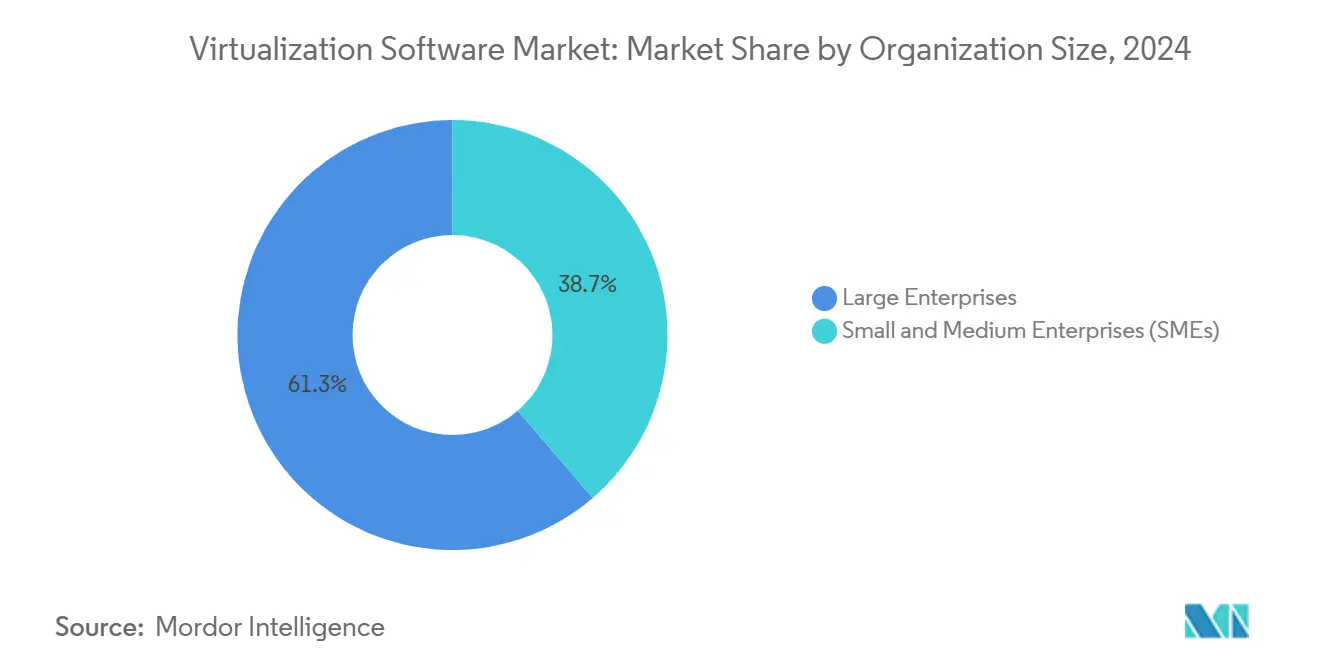
By End-user Industry: Healthcare Leads Digital Transformation
IT and telecommunications held a 28.4% stake in 2024, reflecting early adoption of cloud and NFV. Healthcare and life sciences, however, are poised for a 20.1% CAGR through 2030 as telemedicine, electronic health records, and AI-driven diagnostics gain traction. Virtualization enables hospitals to isolate regulated workloads while providing clinicians quick access to patient data. VMware explains that HIPAA and GDPR compliance benefit from policy-based segmentation and encrypted vMotion.
Manufacturing and BFSI sectors deploy virtualized edge nodes to support smart-factory analytics and fraud-detection models near the data source. Government projects aiming for higher productivity see virtualization as a path to remote collaboration and better resource allocation. Media production pipelines likewise rely on GPU-enabled virtual desktops for real-time rendering and secure content distribution.
Geography Analysis
North America dominated the virtualization software market with 34.6% revenue share in 2024, reflecting early adoption, a dense ecosystem of hyperscale providers, and a large installed VMware base. Multiple federal consolidation mandates pushed agencies toward 90% application virtualization, showcasing public-sector leadership. Growth is moderating as enterprises focus on optimization over net-new expansion, though Broadcom’s pricing strategy is triggering evaluations of Microsoft Hyper-V and Nutanix AHV alternatives.
Asia-Pacific is projected to add the most incremental dollars, rising at a 21.4% CAGR to 2030. China finances domestic cloud stacks to enhance technological self-reliance, while India’s government digitization and private-sector modernization initiatives drive broad virtualization uptake. Japanese organizations lead vendor diversification; Virtuozzo’s distribution pact with AXLBIT targets migrating one-fifth of local VMware users within six months. Edge computing deployments tied to 5G roll-outs in South Korea and Australia create additional demand for lightweight hypervisors capable of operating in space-constrained environments.
Europe records steady expansion because GDPR and emerging data-sovereignty legislation make hybrid and on-premise deployments attractive. Germany and the United Kingdom implement sovereign cloud blueprints that keep sensitive datasets within national borders. Fifty VMware Cloud Service Provider partners already deliver sovereign services leveraging VMware Cloud Foundation. France intensifies government cloud mandates, while Eastern European markets explore domestic alternatives to mitigate geopolitical risk. The region’s moderate but resilient growth profile underscores how policy requirements can stimulate virtual infrastructure spending.
Latin America and the Middle East, and Africa remain smaller revenue contributors but present emerging opportunities where mobile-first economies adopt cloud-native virtualization to bypass legacy hardware constraints. Telcos rolling out 5G stand-alone cores rely on virtual network functions to shorten service-introduction cycles. Public-sector digital-inclusion projects across Gulf Cooperation Council states likewise invest in private-cloud platforms backed by virtualization to comply with data-residency laws. These dynamics collectively diversify geographic revenue streams inside the virtualization software market.
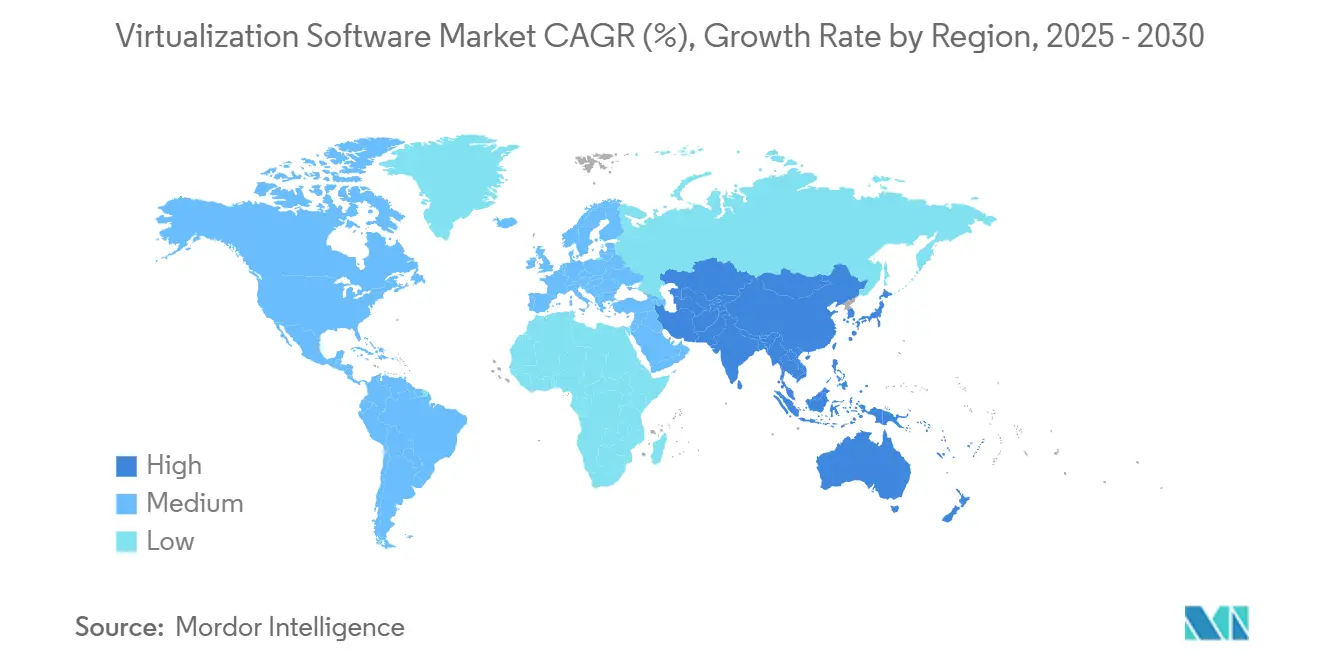
Competitive Landscape
The post-acquisition environment yields a moderately concentrated arena where VMware retains a large installed base yet faces accelerated churn. Microsoft, Red Hat, and Nutanix capture new workloads by bundling migration assessment tools and flexible subscription plans. Nutanix posted USD 2.14 billion in annual recurring revenue on 18% growth, attributing the gain to hybrid multi-cloud traction. Red Hat positions OpenShift Virtualization as a bridge between VMs and containers, useful for phased modernization.
Emerging challengers target edge environments and SME buyers. Scale Computing promotes integrated hyperconverged appliances combined with KVM, highlighting autonomous failover suitable for remote branches. Proxmox Server Solutions capitalizes on open-source transparency and low entry cost, gaining mindshare where licensing increases hit hardest. Sovereign cloud specialists partner with local datacenter operators to deliver compliance-ready stacks, particularly across Europe.
Innovation themes include AI-driven resource-planning engines, zero-trust secure enclaves, and unified dashboards spanning VM, container, and serverless domains. Patent filings covering predictive desired-state analysis reflect vendor focus on self-healing infrastructure. [4]USPTO, “System and Method for Generating and Recommending Desired State of Virtualization Software,” Google Patents, patents.google.com Success hinges on simplifying migration from vSphere, embedding security, and offering consumption-based pricing. Vendors meeting these criteria are positioned to increase their share in the virtualization software market.
Virtualization Software Industry Leaders
-
VMware Inc.
-
Microsoft Corporation
-
Citrix Systems Inc.
-
Red Hat Inc. (IBM Corporation)
-
Nutanix Inc.
- *Disclaimer: Major Players sorted in no particular order
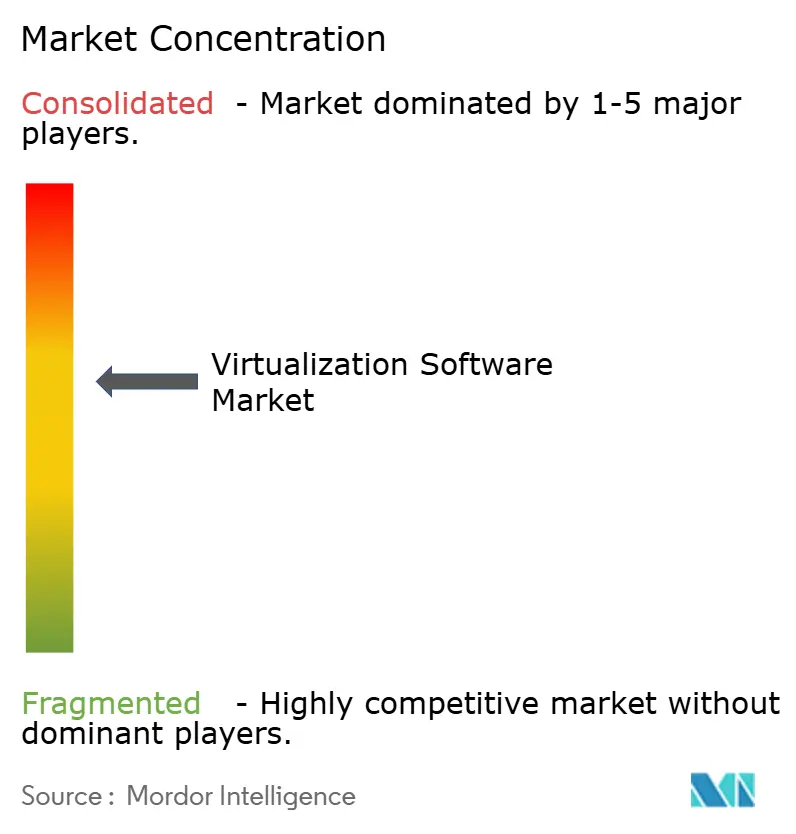
Recent Industry Developments
- June 2025: Broadcom introduced VMware Tanzu Platform 10, cutting private-cloud footprint by up to 70% and adding GenAI governance features.
- May 2025: Nutanix reported fiscal Q3 2025 ARR of USD 2.14 billion, up 18% year over year, citing hybrid multi-cloud demand.
- April 2025: IBM closed its USD 6.4 billion acquisition of HashiCorp, enhancing enterprise virtualization automation capabilities.
- April 2025: Virtuozzo signed a distribution agreement with AXLBIT to migrate 20% of Japanese VMware users within six months.
- March 2025: Broadcom launched VeloSky, a converged networking solution integrating fiber, cellular, and satellite via virtualized overlays.
- February 2025: Microsoft recorded Q2 2025 cloud revenue of USD 40.9 billion, up 21%, boosted by AI-integrated virtualization platforms.
- November 2024: Broadcom enhanced VMware Cloud Foundation with ESXi Live Patching and AI/ML workload support.
Research Methodology Framework and Report Scope
Market Definitions and Key Coverage
Our study defines the virtualization software market as revenues generated from hypervisor-based platforms and related management suites that abstract compute, storage, network, or desktop resources so multiple operating systems or containers run concurrently on standard hardware. The model tracks license, subscription, and support fees across on-premise, cloud, and hybrid deployments for server, desktop, network, storage, and application virtualization.
Scope exclusion: standalone container orchestration stacks that operate without a hypervisor layer are outside this study.
Segmentation Overview
- By Platform
- PC/Server Virtualisation
- Mobile/Endpoint Virtualisation
- By Virtualisation Category
- Application Virtualisation
- Network/SD-Network Virtualisation
- Server/Compute Virtualisation
- Storage Virtualisation
- By Deployment Model
- On-premise
- Cloud/SaaS-hosted
- Hybrid
- By Organization Size
- Large Enterprises
- Small and Medium Enterprises (SMEs)
- By End-user Industry
- IT and Telecommunications
- BFSI
- Healthcare and Life Sciences
- Manufacturing
- Government and Defence
- Media and Entertainment
- Other End-user Industries
- By Geography
- North America
- United States
- Canada
- Mexico
- South America
- Brazil
- Argentina
- Chile
- Rest of South America
- Europe
- Germany
- United Kingdom
- France
- Italy
- Spain
- Russia
- Rest of Europe
- Asia-Pacific
- China
- India
- Japan
- South Korea
- Singapore
- Malaysia
- Australia
- Rest of Asia-Pacific
- Middle East and Africa
- Middle East
- United Arab Emirates
- Saudi Arabia
- Turkey
- Rest of Middle East
- Africa
- South Africa
- Nigeria
- Egypt
- Rest of Africa
- Middle East
- North America
Detailed Research Methodology and Data Validation
Primary Research
To close gaps, we interviewed enterprise infrastructure architects, hyperscale cloud capacity planners, value-added resellers, and open-source maintainers across North America, Europe, and Asia-Pacific. Their inputs on hypervisor replacement cycles, VM-to-container ratios, and regional pricing adjustments helped us validate assumptions and fine-tune growth levers.
Desk Research
Mordor analysts first mapped the demand pool using freely available tier-1 sources such as the US Bureau of Economic Analysis ICT spending tables, Eurostat cloud adoption surveys, Japan's METI server shipment data, NIST virtualization security guidelines, and peer-reviewed work on hypervisor density from IEEE Xplore. Company 10-Ks, investor decks, trade-association white papers, and curated news hits from Dow Jones Factiva and D&B Hoovers then supplied pricing trends, license mix shifts, and vendor share signals. The publicly listed sources cited illustrate the breadth; many additional references supported data checks.
Market-Sizing & Forecasting
A top-down construct begins with global IT hardware outlays, aligns server shipments and cloud capex, and applies virtual machine penetration and average license cost multipliers. Selective bottom-up roll-ups of supplier revenue disclosures and channel checks corroborate totals. Key variables include x86 server shipments, average VM density per host, public cloud IaaS spend, hypervisor ASP shifts, and regional data-center capacity additions, each forecast through multivariate regression supported by scenario testing. Where bottom-up evidence is sparse, proxy metrics such as rack power installations are used with conservative load factors.
Data Validation & Update Cycle
Outputs pass three-layer variance checks, peer review, and senior-analyst sign-off. Models refresh annually and are re-run when material events, large M&A, and pricing resets or regulatory changes occur, ensuring clients receive the latest viewpoint.
Why Mordor's Virtualization Software Baseline Stands Out for Decision-Makers
Published estimates often diverge because firms choose different virtualization layers, bundle security or NFV differently, and refresh data on varied cadences.
Key gap drivers include: some studies lump adjacent markets like container platforms or disaster-recovery suites; others apply uniform license prices across geographies; a few project growth from historical CAGR without checking server-shipment slowdowns. Mordor's definition, selective variable set, and yearly bottom-up validations minimize such distortions.
Benchmark comparison
| Market Size | Anonymized source | Primary gap driver |
|---|---|---|
| USD 94.82 B (2025) | Mordor Intelligence | - |
| USD 81.60 B (2024) | Global Consultancy A | Bundles virtualization security and NFV modules |
| USD 41.88 B (2024) | Industry Journal B | Excludes cloud-hosted hypervisor subscriptions |
These contrasts show that Mordor's carefully delimited scope, multi-variable modeling, and annual update cadence deliver a balanced, transparent baseline that technology suppliers and investors can trust when calibrating strategy and budgets.
Key Questions Answered in the Report
What is the current value of the virtualization software market?
The virtualization software market generated USD 94.82 billion in 2025 and is forecast to reach USD 218.76 billion by 2030.
Which region is expanding the fastest?
Asia-Pacific is projected to grow at 21.4% CAGR from 2025 to 2030, supported by cloud investments and multi-cloud adoption.
Why are enterprises moving away from VMware vSphere?
Broadcom’s revised licensing has raised costs by 150%–500%, encouraging CIOs to adopt alternative hypervisors and container-centric platforms.
Which platform segment shows the highest growth?
Mobile and endpoint virtualization leads with a 22.1% CAGR as hybrid work normalizes secure remote-desktop demand.
How will network virtualization evolve during 5G roll-outs?
Network and software-defined networking virtualization is expected to grow at 21.2% CAGR due to programmable infrastructure needs for 5G and edge applications.
What challenges could slow market expansion?
Deployment complexity, escalating subscription fees, and a growing virtualization-specific attack surface may temper the growth trajectory despite robust demand.
Page last updated on:



